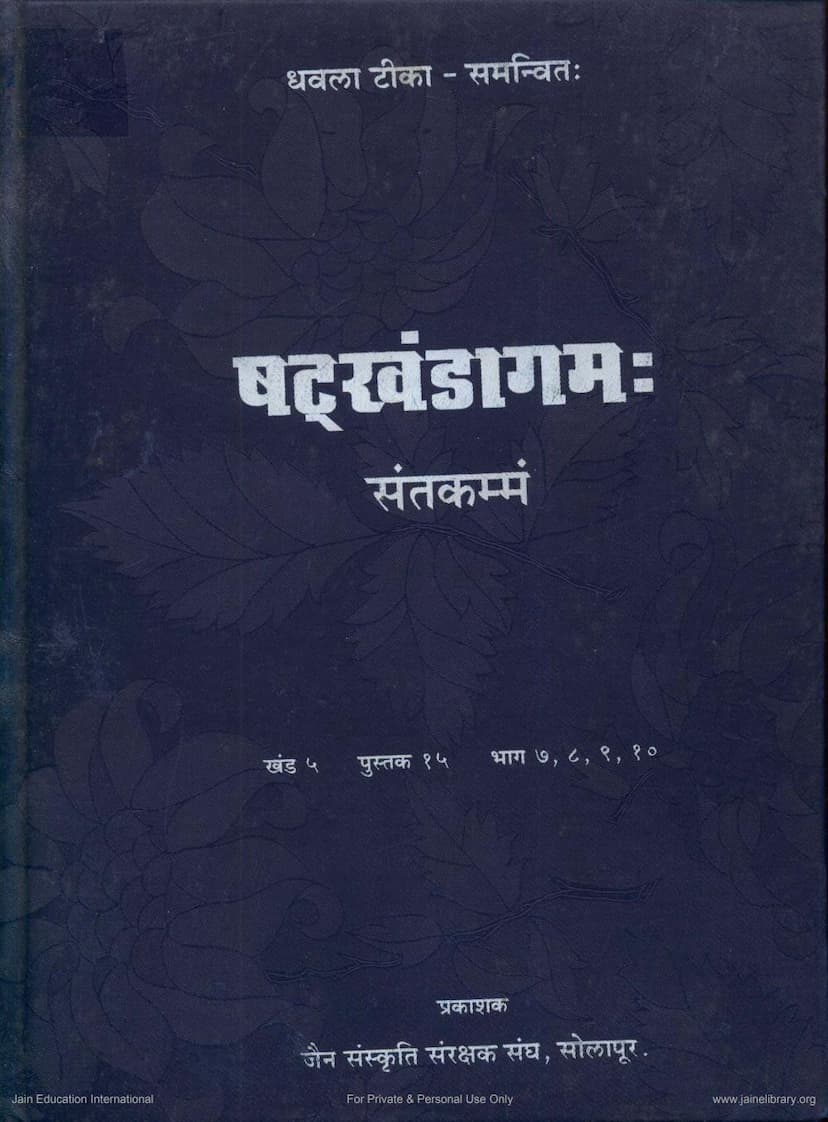Shatkhandagama Pustak 15
Added to library: September 2, 2025

Summary
This book, the fifteenth volume in the Jivaraj Jain Granthamala's Dhavala series, is the seventh part of the fifth Khanda (section) of the Shatkhandagama, authored by Pushpadanta and Bhutabali, and commented upon by Veerasena. It is titled "Santakamma Khand 5, Pustak 15" and covers volumes 7, 8, 9, and 10 of the Dhavala commentary.
This volume focuses on the remaining eighteen Anuyogadvaras (topics of inquiry) within the Santakamma section of the Karma Prakriti Prabhut, which were not originally covered by the sutras of Bhutabali. The Dhavala commentary by Virasena fills this gap. Specifically, this book presents the exposition of the first four of these eighteen Anuyogadvaras:
-
Nibandhana Anuyogadvāra (7): This section deals with the concept of "Nibandhana," which relates to what is bound within what, based on the definition "Nibadhyate tad asminn iti Nibandhanam." It discusses various classifications of Nibandhana, including name, establishment, substance, space, time, and mode. The text clarifies that while the Nibandhana Anuyogadvāra generally discusses the binding of all six substances, it focuses specifically on the karma aspect of binding due to its spiritual significance. It outlines two types of non-agamic karma substance binding: Mool Karma Nibandhana (root karma binding) and Uttar Karma Nibandhana (subsequent karma binding).
-
Prakrama Anuyogadvāra (8): This section defines "Prakrama" as "Prakramati iti Prakramah," referring to the accumulation of karmic matter. It explains the six types of Prakrama: name, establishment, substance, space, time, and mode. The text addresses the philosophical debate regarding the origin of karma from an akarmic state (non-action), refuting the Sankhya theory of Satkaryavada (pre-existing effect) and Buddhist theory of Kshanikshaya (momentary destruction). It establishes that the work is neither completely identical nor completely different from the cause, reflecting the principle of Syadvada (the doctrine of maybes). The discussion then details the classification of Prakrama into natural and unnatural, and further elaborates on Prakrama related to Gati (destination), Bandha (karma bondage), Bandhaniya (what is to be bound), Bandhaka (the binder), and Bandha Vidhana (the method of bondage). It also delves into the nuances of Prakrama of qualities like Prakriti, Sthiti, and Anubhaga.
-
Upakrama Anuyogadvāra (9): This section defines "Upakrama" and its various aspects, similar to Prakrama. It highlights the distinction between Prakrama, which pertains to the beginning of karmic attachment, and Upakrama, which describes the activities of karmic matter from the second moment of bondage until its existence. The text meticulously details different types of Upakrama, including Bandhanopkrama (bondage Upakrama), Udīraṇāopkrama (emission Upakrama), Upashamanaopkrama (suppression Upakrama), and Vipariṇāmaopkrama (transformation Upakrama). Each of these is further subdivided and explained with respect to ownership, time, and comparative analysis based on the number of souls. It elaborates on Udīraṇā, explaining it as the process of bringing karmic matter into the Udayavali (the time frame for karmic effect) from beyond it, and discusses its two types: Ek-ek Prakriti Udīraṇā (emission of individual karmic natures) and Prakriti Sthāna Udīraṇā (emission of karmic states).
-
Udaya Anuyogadvāra (10): This section defines "Udaya" as the fruition of karma. It categorizes Udaya into Prakriti Udaya (fruition of karmic nature), Sthiti Udaya (fruition of karmic duration), Anubhaga Udaya (fruition of karmic intensity), and Padesa Udaya (fruition of karmic particles). The text elaborates on these categories, discussing their ownership, time, comparative analysis, and the meaning of Udaya in the context of various karmic permutations. It also includes detailed discussions on the concept of Sannikarsa (proximity) in relation to Udaya.
The book also includes the Santakarma Panjika, a commentary on these four Anuyogadvaras, which provides further clarification on complex or subtle points. The editors, Late Dr. Hiralal Jain, Late Pt. Phoolchandra Siddhanta Shastri, and Late Pt. Balachandra Shastri, along with the publisher Jain Sanskruti Samrakshak Sangh, Solapur, have ensured a revised second edition in 1995, with contributions from research assistants like Late Dr. A. N. Upadhye, Late Pt. Ratanchandji Mukhtar, and Pt. Jawaharlalji Shastri.
The volume is a significant contribution to Jainological studies, offering a detailed and comparative analysis of complex karmic doctrines as explained in the Dhavala commentary.